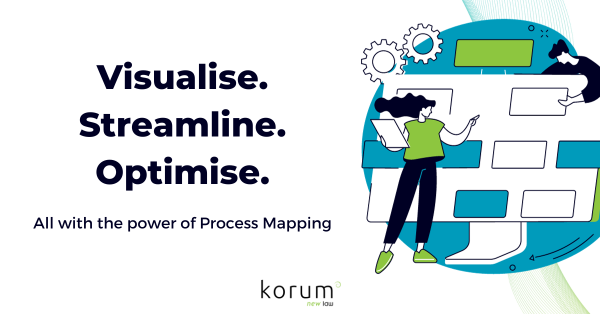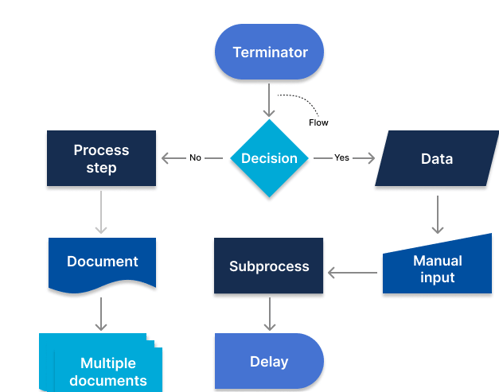The Top 5 Approaches to Process Mapping Explained.

Here at KorumLegal we love efficiency and work with our customers to optimise their businesses, particularly through our P+T Solution (Process + Tech). Coming out of a dark few years we are seeing a number of organisations go through significant transformations that they put on hold whilst we all focused on getting through the “C-years". So, we thought this might be a good time to go back and look at the various ways that a team can go about analysing and improving their processes…Back to Basics if you like.
For most companies it is imperative to be constantly seek ways to streamline their operations, enhance efficiency, and improve overall performance. There are now plenty of options and methodologies for going about this, and process mapping has emerged as a valuable tool in achieving these goals. By visually representing workflows, identifying bottlenecks, and clarifying roles and responsibilities, process mapping helps organisations gain a comprehensive understanding of their operations. In this article, we will delve into the top 5 approaches to process mapping, shedding light on their unique benefits and applications.
Finger 1- The basics of flow charting

What is Process Mapping?
1. Introduction to Process Mapping
Process mapping, as a concept, has its origins in the early 20th century when it was first utilised in manufacturing industries to improve efficiency and reduce waste. However, today, it finds applications across various sectors, from manufacturing and healthcare to finance and technology.
Companies of all sizes, from startups to multinational corporations, engage in process mapping to gain insights into their operations. This practice helps them identify areas for improvement, optimise processes, and ultimately enhance their bottom line.
2. The Definition of Process Mapping
At its core, process mapping is a visual representation of a sequence of activities or steps that collectively accomplish a specific task or produce a particular output. It involves the use of various symbols and diagrams to illustrate how workflows from one stage to another within an organisation.
Businesses use process mapping for several reasons, including:
- Improved Efficiency: Identifying inefficiencies in processes allows for optimisation and resource allocation.
- Enhanced Clarity: Visual representations make complex processes easier to understand.
- Bottleneck Identification: Pinpointing bottlenecks helps in resource allocation and optimisation.
- Streamlined Decision Making: Clear process maps aid in informed decision-making.
With these benefits in mind, let's explore the top 5 process mapping approaches in detail.
The Top 5 Process Mapping Approaches
A. Process Mapping Approach #1: High Level Process Mapping
-
Description of High-Level Process Mapping
High level process mapping, also known as macro-level mapping, provides an overarching view of an organisation's operations. It focuses on major process steps, offering a simplified representation of how various activities interconnect.
-
How it Provides an Overview
This approach serves as the starting point for more complex process mapping. It allows organisations to understand the broad strokes of their workflows before delving into finer details. High level process maps are often used when companies need to grasp the general flow of operations quickly.
-
Use Case and Example
Consider a customer service department within a telecommunications company. High level process mapping might outline the key stages of handling incoming customer inquiries, such as initial contact, issue assessment, and resolution.
B. Process Mapping Approach #2: Detailed Process Mapping
-
Description of Detailed Process Mapping
Detailed process mapping, also known as micro-level mapping, goes a step further by dissecting individual process steps. It provides an in-depth view of how each activity contributes to the overall process.
-
How it Delves Deeper
This approach complements high-level process mapping by zooming in on the intricacies of each task. It helps organisations understand the specific actions, dependencies, and inputs required for each step.
-
Real World Example
Continuing with the customer service department example, detailed process mapping might break down the "issue assessment" stage into sub-steps like data collection, analysis, and solution proposal. This level of granularity helps identify areas for improvement.
C. Process Mapping Approach #3: SIPOC
-
Introduction to SIPOC
SIPOC is an acronym for Suppliers, Inputs, Process, Outputs, and Customers. It originated from the Six Sigma and Total Quality Management (TQM) methodologies. This approach focuses primarily on the inputs and outputs of a process, providing a simplified overview.
-
SIPOC Key Focus
SIPOC emphasises the relationships between suppliers, inputs, processes, outputs, and customers. It offers a high-level understanding of these elements but does not delve into the intricacies or dependencies between individual process steps.
-
Use Case/Example
In the context of a manufacturing company, a SIPOC diagram might outline the suppliers (raw material providers), inputs (raw materials), process (production line), outputs (finished products), and customers (end-users or retailers). This helps identify the key stakeholders and materials involved in the production process.
D. Process Mapping Approach #4: Swimlane
-
What are Swimlane Diagrams?
Swimlane diagrams are a specialised form of process mapping that allocate process steps to specific individuals or departments. Each "swimlane" represents a particular entity or role within the process.
-
Benefits of Swimlane Diagrams
Swimlane diagrams are particularly useful for identifying redundancies, bottlenecks, and clarifying roles and responsibilities within complex workflows. They visually separate tasks based on who is responsible for them, making it easier to pinpoint inefficiencies.
-
Use Case/Example
Imagine a project management process in a software development company. A swimlane diagram might allocate tasks to different departments, such as design, development, testing and quality assurance. This visual representation helps identify which department is causing bottlenecks and delays.
E. Process Mapping Approach #5: Value Stream Map
-
Overview of Value Stream Mapping
Value Stream Mapping (VSM) is a comprehensive approach that focuses on adding value to processes while eliminating waste. It is often considered one of the more complex methods of process mapping.
-
Value Stream Mapping: Adding Value and Eliminating Waste
VSM scrutinises every aspect of a process to determine what adds value from the customer's perspective and what constitutes waste. This approach aims to streamline processes by removing non-value-adding activities.
-
Use Case/Example
In a healthcare setting, a Value Stream Map could analyse the patient journey from check-in to discharge. By identifying and eliminating unnecessary steps, wait times can be reduced, and overall patient satisfaction increased.
The Benefits of Process Mapping
Process mapping offers several significant benefits to organisations of all sizes and across industries. Here are some of the key advantages:
A. Improved Efficiency and Production
By identifying inefficiencies and bottlenecks, process mapping allows organisations to optimize workflows, allocate resources more effectively, and ultimately improve production efficiency.
B. Enhancing Clarity and Communication
Visual representations of processes make it easier for employees to understand their roles and responsibilities. This clarity enhances communication within the organisation and reduces misunderstandings.
C. Identification of Bottlenecks
Process mapping helps pinpoint bottlenecks and areas where work gets delayed. Addressing these bottlenecks can lead to smoother operations and quicker project completion.
D. Streamlined Decision Making
With a clear understanding of their processes, organisations can make informed decisions about resource allocation, process optimisation, and strategic planning.
Conclusion
Process mapping is a powerful tool for organisations seeking to enhance their operations and improve efficiency. The top 5 process mapping approaches—high level mapping, detailed mapping, SIPOC, swimlane diagrams, and Value Stream Mapping—each offer unique benefits and are suitable for different scenarios.
The choice of approach depends on the specific needs of the organisation and the complexity of the processes in question. It's essential to select the right approach to ensure that the mapping process is effective in achieving its objectives. And of course then there are the tools that are available to support process mapping….but that’s another article entirely.
At KorumLegal, we understand the importance of selecting the right process mapping approach for your business. Our experienced team can guide you through the process, helping you identify the most suitable approach and assisting in its implementation. Contact us today to streamline your operations, enhance efficiency, and achieve your business goals through effective process mapping.
If you want to read more about process mapping or the importance of ensuring you have great processes you can read more here:
https://www.korumlegal.com/blog/marie-kondo-your-legal-department
https://www.korumlegal.com/blog/what-is-process-mapping-and-how-can-it-help
Natasha Norton
Oct 9, 2023
Related Posts.
By: Natasha Norton
What is an Alternative Legal Service Provider (ALSP)? Exploring a New Frontier in Legal Support
The legal industry, once known for its traditional and conservative practices, has undergone (and continues to undergo) a significant transformation. One of the key factors driving this change is the..
By: Joao Costa
What Is Process Mapping and How Can It Help?
Process Mapping is an operations management tool used to create a graphic representation of how things get done in a certain situation. It helps interested parties to visualise the details of a..
